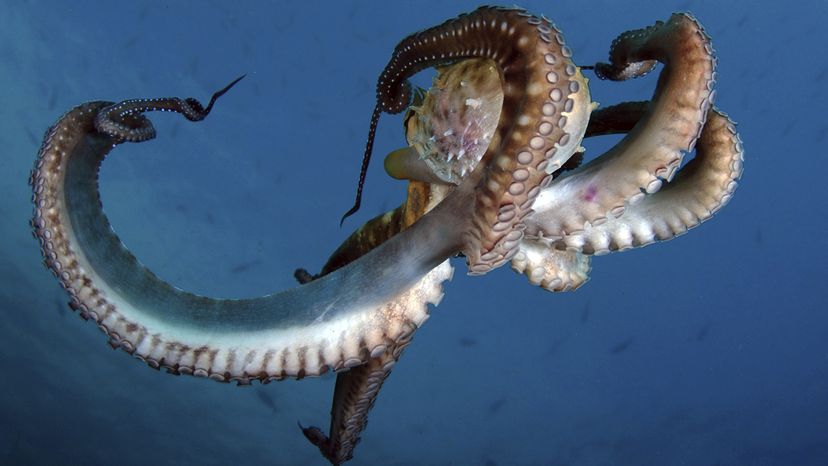
The octopus is a surprisingly complex creature and, quite possibly, the world's original "blue blood." Its 500 million neurons are distributed throughout its head and body, compared to the 100 billion neurons in our brains [source: Courage]. The octopus's brain power isn't easily apparent at first glance, but it's proven itself capable of planning, reasoning and -- predicting sporting matchups. On the planning front, researchers have discovered that octopuses in Indonesia will gather coconut shell halves in preparation for stormy weather, then take shelter by going inside the two pieces of shell and holding it shut [source: Courage].
If you asked Jean Boal, a behavioral researcher at Millersville University about the inner life of octopuses, she might tell you that they are cognitive, communicative creatures. Boal attempted to feed stale squid to the octopuses in her lab and one cephalopod sent her a clear message: It made eye contact and used one of its arms to shove the squid down a nearby drain, effectively telling her that stale food would be discarded rather than being eaten [source: Courage].
Advertisement
So what makes these smart sea creatures so adaptable? The ability is literally in their blood. The same pigment that gives the octopus blood its blue color, hemocyanin, is responsible for keeping the species alive at extreme temperatures. Hemocyanin is a blood-borne protein containing copper atoms that bind to an equal number of oxygen atoms. It's part of the blood plasma in invertebrates.
Blue-hued hemocyanin binds to oxygen in the blood and transports it throughout the octopus's body to supply tissues, a critical factor in its survival. Octopuses have three hearts and need more oxygen than most other invertebrates, so the hemocyanin allows octopuses to get a steady oxygen supply, even when it isn't readily available in their environment. It also ensures that they survive in temperatures that would be deadly for many creatures, ranging from temperatures as low as 28 degrees Fahrenheit (negative 1.8 degrees Celsius) to superheated temperatures near the ocean's thermal vents [source: Sirucek].
Researchers suspect the "blue blood" adaptation is the result of the octopus's inability to migrate away from challenging environmental conditions. The animals move primarily by crawling along the seafloor and have relatively short lives, making traditional migration out of the question [source: Society for Experimental Biology]. By contrast, mammals' blood (including ours) is red because it contains iron-rich hemoglobin [source: Sirucek].
Advertisement